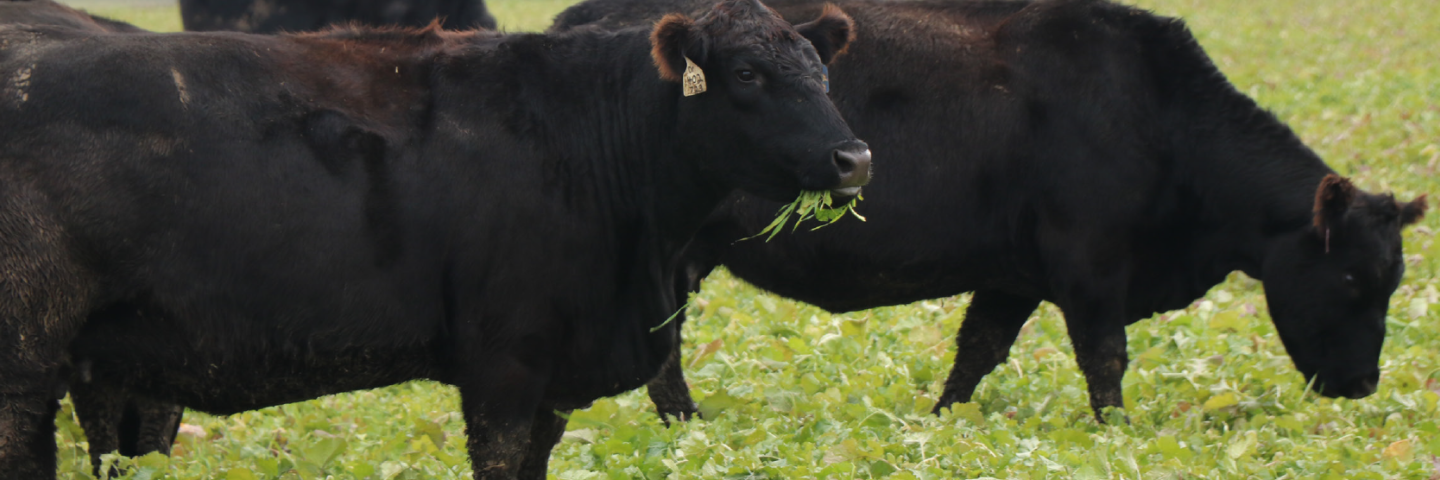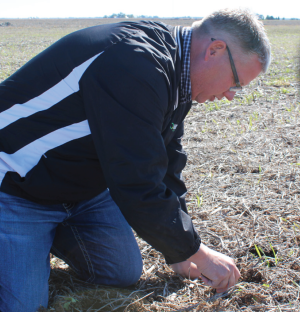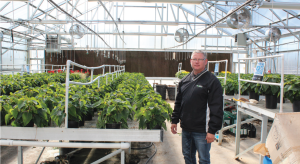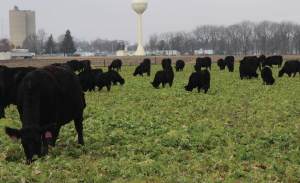
Grazing on Prime Farmland? Why Not?
Doug Hanson
Iroquois County, IL
Doug Hanson farms nearly 1,000 acres in Iroquois County, Illinois. He also grazes a 65-head of beef cattle on 76 acres using a rotational system planted to grass, forage, and cover crops of summer and winter annuals. He uses no-till and strip-till and is a fourth-generation farmer and beef producer. Doug’s path in agriculture has been non-traditional, to say the least, but he leads the pack when it comes to ingenuity. Through it all, a commitment to conservation lies at the heart of his purpose.
Doug grew up on a grain farm that was primarily corn and soybean production. His grandfather would feed out around 200 fat steers in a confinement setting. Iroquois County had transitioned over to mostly row crops in the 1980’s, leaving little diversification opportunities. Doug and his sisters started showing cattle in 4-H, but their FFA cattle experience brought new opportunities when Doug started showing heifers and buying more cows. Back then, pasture and hay ground were not options. His cows lived on grassed waterway hay and were supplemented with cheap corn.

“I loved living on the farm and showing cattle. I always knew I’d be involved in agriculture. It’s in my family’s bloodline,” Doug explains. But everything changed in the 1980’s. Suddenly, it was ALL row crops with no room for livestock. Farmers took out trees and planted grain everywhere possible. “Either you were growing corn and soybeans, or you had acres in the Conservation Reserve Program. Those were you’re only options,” Doug said.
After graduating from Illinois State University in Agriculture Education, Doug made some life changes. Unhappy with a monoculture agriculture lifestyle in Iroquois County, he and bride Lisa moved to Waterloo, Illinois in Monroe County. The soil and landscape were different there, as was the attitude of running a diversified farm. Doug taught high school agriculture for eight years and continued raising beef cows on three farms using traditional grazing. Doug was one of the first people in Illinois to sign up a grazing farm as an NRCS EQIP project. He learned about grazing and got one perimeter fence built before the landowner surprised him and sold the farm.
In 2001, the Hanson’s (family and his herd) headed back to Danforth, Illinois, moving in next to Lisa’s parents on the farm where she was raised. Doug became Clifton Central High School’s Ag Teacher and taught until 2005. Those first few years back home were a whirlwind of activity. Besides helping his Ag Business Management students start a school Feed Store, he worked with local NRCS staff to create a new grazing plan and access both technical and financial help through EQIP. With working full-time, taking care of his home, starting a family, raising cows, and helping his parent’s farm, Doug was busy!
Doug used EQIP to create and pay for his intricate plan for a rotational grazing system. His contract included a grazing plan, about 27,000 feet of exterior and interior fence, pipeline, watering facilities, pasture seeding and a winter-feeding station. But pasture is only part of Doug’s operation. He grows corn and soybeans on another 950 acres on five farms located nearby in Iroquois County.
Doug’s EQIP Contract
While Doug was highly motivated to install all his EQIP conservation practices on the land quickly, his life, job, and other passions stretched implementation over a six-year period. When Doug started his EQIP project, corn was around $2.50 a bushel. It looked like raising cattle may be a smart idea. By the time Doug finished building all the fences, the winter feeding station, and putting in 16 watering stations? Corn jumped to $5.00 and people thought he was crazy. Putting cattle on flat black ground that can raise over 200-bushel corn raised some eyebrows. Doug held his ground.
Doug was a full-time teacher because he loved it, but there’s another reason most farmers understand: Health Insurance. “You need someone in the marriage with a day job and health care benefits if you’re going to make it. That’s just a reality,” Doug explains. In 2005 Doug combined his passion for production agriculture and education and started working for a local seed company that has its own brand of corn, wheat, and soybeans along with forages. That company grew, expanded to include cover crops, and eventually became ProHarvest Seeds. By 2011, cover crop popularity exploded and they made Doug their Forage and Cover Crop lead.

Hanson wanted to combine productive soils with livestock and cover crops. It was the best thing to do, but not in the eyes of most area farmers. Doug began experimenting and became proficient at planting summer annuals and cover crops to increase summer grazing. This extended grazing into winter months by stockpiling feed. Doug used this strategy to supply his herd all they needed from forage and feed grown directly on his land.
Doug started out renting eight acres of pasture from Lisa’s mom. Now, his 76-acre operation and never-ending pasture experiments continue to expand. Doug’s pasture soils stay wet when they get wet. Under these conditions, the herd can tear things up. Bottom line: He can’t have “permanent” pasture on all his soils. His goal? Put 60% of pastures in grass and forage plantings and 40% in annuals. It’s manageable and sustainable.
Why use summer annuals? They give a livestock operation added flexibility—twice the tonnage of feed and great quality. Granted, it’s more to manage, it’s more work, and an extra expense, but using annuals alongside cover crops benefits the soils and the herd. Doug reseeds each paddock every five to eight years, planting annuals and incorporating cover crops using vertical tillage in September. Using that date, he plants cover crops and applies fertilizer simultaneously. By regularly reseeding pastures, Doug follows NRCS technical standards for good pasture management. “Most growers think you plant a pasture once and it lasts 50 years or more. That’s not the case,” says Doug. “You’ve got to keep things diverse. Keep it healthy.”
Doug is creating regenerative ag strategies to raise cattle, generate profits, and protect natural resources. He never stops looking for new ways to make better operational decisions. “I used to select seed and species to grow the best grass for my herd. Now I base decisions on what seed mix and management methods are best for my soil. With those choices, everybody wins,” says Doug.
Never Stop Learning
A few years ago, Doug and a buddy purchased a 60’ “Twin Row” planter. Their special project was to more strategically place cover crops to benefit next year’s crop. He first sets his planter for 2 rows at an 8” spacing with a 22” gap, establishing a winter-kill mix of oats and radish. Then he uses RTK technology to re-plant the field, splitting the 22” gap with a cover crop cocktail mix that includes a non-winter kill mix of either annual rye grass or winter rye. These two passes allow him to no-till corn into dead vegetation with oats and radish, while allowing rye to grow longer prior to chemical killing around corn planting time or shortly thereafter. This provides the benefit of increased organic matter, a stable driving area in wet conditions, and reduces weed pressure. That’s doing the right thing at the right place at the right time.
Doug’s other big EQIP project was his Winter Feeding Station, a covered structure that houses feed and manure during harsh winter conditions. Installed in 2008, the structure—precisely positioned—offers the perfect option for cows and especially young calves, when weather, fields, and pasture conditions are poor. “The station and rock covered access roads provide benefits and improvements I can’t even begin to calculate,” Doug says with a smile.
Hanson’s grazing operation is located close enough to Chicago, Bloomington, and Champaign to be a sweet— and profitable—spot to grow and sell locally raised beef. The farm is currently selling grain-finished freezer beef, but the goal is to transition to grass-finished. Grass-fed operations require long-term planning skills to be successful. According to Doug, you look ahead at least three seasons—even three years—and be ready to make constant adjustments.
Ready For Special Challenges
High Intensity management grazing can definitely be a roller coaster. The short spring of 2018 brought average rye growth for grazing, but the excellent June weather helped get Forage Sorghum and Sorghum Sudan grass planted earlier than normal. Of course, planting is only the beginning. A localized and long-term drought in July and August provided for little growth compared to what Doug expected for high tonnage summer annuals. And then his cool-season perennial pastures were brown that summer. The silver lining came when Doug gave up on summer annuals in early September and planted sixty acres with turnips, radishes, winter rye, barley, annual ryegrass, and oats. This cover crop cocktail got rain right after planting and yielded a lot of forage for fall grazing. These fields will be an excellent place to graze and calve in the spring of 2019.
The 2018 drought conditions Doug encountered were a combination of bad luck, dry weather, and shifty winds. “Like so many other times in my life, mistakes and missteps end up teaching me the most memorable and valuable lessons of all,” Doug says. The job of a good grass farmer is to always have six months of forage out ahead of you. “But to be safe, I’d say have a year’s worth on hand or growing. You never know when and what you’ll need.”
Another important lesson Doug learned is careful management of herd size. Pasture growth, conditions, weather, and herd size must all be in sync. If not, all elements of the operation will suffer. Those costs can impact herd health, pasture and soil viability, and profits.

Based on Doug’s farming enterprise of grazed beef and having tried cover crops and no-till/strip-till on his grain operation, he was eligible for NRCS’s Conservation Stewardship Program, or CSP. This program provides an incentive and an opportunity to ‘try out’ even more innovative conservation solutions all over his operation. That makes CSP the perfect program for a curious, home-grown experimenter and a guy who never stops learning.
Using CSP Doug planted cover crops on 100% of his corn/soybean acres after (or before) harvest for the past four years while using No-till/Strip-till on all acres.
Doug is living proof there are new options for growers in the Corn Belt. There’s a way to grow something besides corn out here on flat, Illinois soils. “We can create profitable farms, build healthy soils, reduce erosion, and improve water quality. There’s not just one way, one option,” Doug explains. Diverse opportunities in Illinois are still viable. Doug believes we can have all that again if we’re willing to make changes and do things differently. “Today’s farmers need to think different. Take advantage of both new technologies and old-time common sense,” Doug says.
Doug hopes to see more livestock back on Illinois farms. He joined the Illinois Beef Association Board of Governors with the goal of increasing the number of beef cows in Illinois. “If we combine insurable crop production acres alongside grazing livestock pasture systems and cover crops, I think it will create a sustainable operation that can reduce risk and provide market-driven products that are profitable. This is a great way to improve a farming operation without leveraging high dollar cash rent. It may allow a younger family member to return to the farm with less debt and risk.”
EQIP & CSP Conservation Practices on Hanson Operation:
- Grazing Management Plan
- 4,100 feet of Pipeline & Livestock Watering Facilities
- Pasture & Hayland Plantings
- Access Road & Heavy Use Area
- Comprehensive Nutrient Management Plan
- Winter Feeding Station
- 27,000+ ft of fencing (~12,350 feet exterior; ~14,900 feet interior)
- No-Till/Strip-Till Planting & Cover Crops
To learn how USDA’s NRCS can help your livestock operation or address natural resource concerns, call your local county office today. Visit Illinois NRCS to find the office closest to you.

